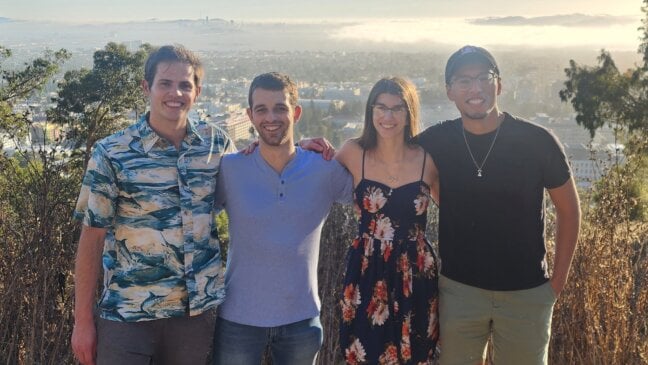Amplifying the Joy of Math: Desmos’ Next Chapter
by Tony Wan, Head of Investor Content
Art brings math to life, and vice versa. Of the thousands of stories I’ve filed as a former journalist, one of the most delightful has been Desmos’ student art contest. The creativity and complexity of the submissions — with every line, curve, shade and highlight represented by an equation — is testament to the brilliance of students, empowered by top-notch technology.
It underscores how math can embody and exude joy, a feeling that is shared across the many tools, activities and vibrant user communities that Desmos has built since its start in 2011. Along the way, the company has consistently pushed the boundaries of what a graphing calculator can do, of what math is, and how it can be taught, experienced and enjoyed.
As Desmos CEO and co-founder Eli Luberoff said at the time: “We believe that the line between math, arts and humanities is a lot blurrier than what most people make it out to be. Math isn’t just the regurgitation of formulas. It can be about expression and creativity, and we want to give students every opportunity to create things using math.”

The company began with a simple, equitable premise: to eliminate the need for students to fork out hundreds of dollars for graphing calculators. That was the genesis of the calculator, now a universally accessible tool reaching tens of millions of students. It’s been translated into over 30 languages, works with screen readers and braille displays, and is embedded in content from over 75 leading education publishers and test makers including The College Board and The International Baccalaureate.
To that objective, sales of graphing calculators are reportedly on the decline, on order of 15% annually.
But Desmos’ vision extends far beyond displacing graphing calculators. Its mission is to help everyone love learning math, and to do that, it is changing how math is taught. That means encouraging inquiry, experimentation and reflection, instead of rote drilling and abstract problems solving for x. With a team of instructional designers and educators, including Chief Academic Officer Dan Meyer, a renowned math researcher and former teacher, Desmos created a library of fun, interactive activities and lesson plans that leveraged its calculator as a creative canvas. (Turtle Crossing and Marbleslides are among my favorites.)
In 2018, that effort evolved into a more ambitious undertaking: to remake the math curriculum. It’s not a business for the faint of heart. But the company has fused its technology, design and pedagogy into a core, middle-school math curriculum currently used by more than 300,000 students across 46 states and 14 countries.
Its growth comes at a time when digital instructional materials have convincingly overtaken print (finally). And to take its curriculum to the next level, Desmos is joining forces with an emerging leader in the K-12 edtech industry.
Today, Desmos is announcing the sale of its curriculum and instructional technology to Amplify, a partner it has known well over the years through the integration of Desmos’s calculators and lesson technology. Together, they will continue to build immersive, impactful math curricula, supported by resources to make them accessible to many more teachers and students across the U.S. Under Amplify CEO Larry Berger, one of the most respected voices and experienced leaders in edtech, many exciting opportunities lie ahead to leverage Desmos’ technology not just to other math grades, but also to science, literacy and many other subjects.
Throughout Desmos’ growth and expansion, what has never wavered is its uncompromising dedication to rigor and quality. That is ingrained in the DNA of a humble team that truly loves and geeks out on math, and celebrates educators and students who, in turn, are its biggest champions. It’s not uncommon to see artwork created on Desmos appear on TikTok feeds or the front page of Reddit.
Desmos is an exemplar of growth driven by product and community; the headlines and capital later followed. At Reach, we consider ourselves incredibly fortunate to be their largest investor, and to have had the pleasure of working closely with Eli, Eric and the team. Jim Lobdell and Jennifer Carolan served on the Board. Meetings were held in their office atop a motorcycle shop in San Francisco. Between cycles of revving engines, we spent much of our time discussing the curriculum build-out: how to make the development process more efficient while still meeting exacting quality standards; how to position it in the market; and how to make an inquiry-based, conceptual approach to teaching math welcoming to teachers.
Along the way, we saw how each person at Desmos was deeply committed to building tools and curriculum the world has never seen before — ones that would allow students not only to understand math, but love learning about it. This commitment can be seen in the elegance and versatility of its graphing calculator, the magic of the playful animations that hook students to care about otherwise abstract math concepts, and the careful lengths to which the Desmos team goes to support teachers.
The Desmos calculator will remain as an independent Public Benefit Corporation — Desmos Studio — and continue to be led by Eli. All of the Desmos resources that are free today — graphing calculators, lesson-building tools, and lessons — will remain free, whether owned by Amplify or Desmos Studio, and more free tools and features will be added. More details about the curriculum and calculator are available in this blog post from Desmos.

